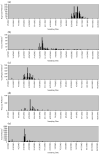Analysis of short-term influences of ambient aeroallergens on pediatric asthma hospital visits
- PMID: 16904733
- PMCID: PMC2233936
- DOI: 10.1016/j.scitotenv.2006.06.019
Analysis of short-term influences of ambient aeroallergens on pediatric asthma hospital visits
Abstract
The objective of our study was to investigate the association between daily pediatric asthma hospital visits and daily concentrations of aeroallergens and their specific species. Records of daily asthma visits in Cincinnati area were retrieved from Cincinnati Children's Hospital Medical Center and aeroallergen sampling was performed by the Button Inhalable Sampler. The Poisson generalized linear model was carried out in which the log of the number of asthma hospital visits was related to aeroallergen level, treated as a continuous variable with adjustment for seasonal time trend, day of the week, ozone and PM(2.5) concentrations, temperature and humidity. The aeroallergens having a significant impact on asthma hospital visits were ragweed, oak/maple and Pinaceae pollen. Their relative risks on asthma hospital visits with respect to a 100 counts/m(3) increase in concentration were in the range of 1.23 to 1.54. The effects in causing the asthma exacerbation were delayed by 3 or 5 days.
Figures


References
-
- Adhikari A, Martuzevicius D, Reponen T, Cho S, Grinshpun S, Sivasubramania S, et al. Performance of the Button Personal Inhalable Sampler for the measurement of outdoor aeroallergens. Atmos Environ. 2003;37:4723–33.
-
- Adhikari A, Reponen T, Grinshpun S, Martuzevicius D, LeMasters G. Correlation of ambient inhalable bioaerosols with particulate matter and ozone: a two-year study. Environ Pollut. 2006;140:16–28. - PubMed
-
- Agata H, Yomo A, Hanashiro Y, Muraki T, Kondo N, Orii T. Comparison of the MAST chemiluminescent assay system with RASAT and skin tests in allergic children. Ann Allergy. 1993;70:153–7. - PubMed
-
- Aizenberg V, Reponen T, Grinshpun S, Wileke K. Performance of Air-O-Cell, Burkard, and Button Samplers for total enumeration of airborne spores. AIHAJ. 2000;61:855–64. - PubMed
-
- Beggs PJ. Pollen and pollen antigen as triggers of asthma–what to measure? Atmos. Environ. 1998;32(10):1777–83.
Publication types
MeSH terms
Substances
Grants and funding
LinkOut - more resources
Full Text Sources
Medical

